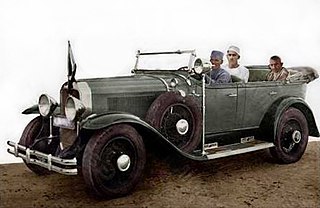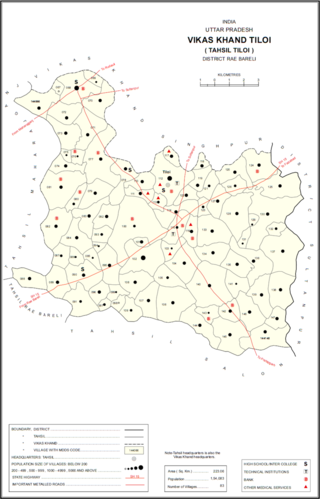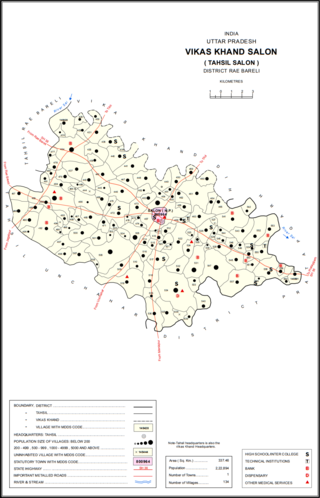Related Research Articles
Samthar is a city and a municipal board in Jhansi district in the Indian state of Uttar Pradesh. Historically before independence of India, it was also known as Samshergarh erstwhile capital of Samthar State

Lal Pratap Singh was a member of the Bisen Rajput dynasty of Kalakankar. He was prominent leader in the Indian Rebellion of 1857. He was killed during the 1858 Battle of Chanda. The Government of India issued a postage stamp on 17 December 2009 to commemorate him.
Pratapgarh was an estate (taluqdari) of Oudh, British India. The rulers of the estate were originally ruling from a place known as Taroul or Tiroul near Allahabad. The ancestor of the family was Babu Sujan Shah, son of Raja Sangram Shah of Tiroul. Later a descendant, Babu Pratap Singh (1628–1683) came to the region known as Rampur and built a fort, and gave the city its current name, Pratapgarh.
Raja Pratap Bahadur Singh (1889–1921) was a Somvanshi Rajput ruler of Pratapgarh Estate of Oudh, British India.

Raja Awadhesh Singh was Raja of Kalakankar estate of Oudh of British India, succeeded by Raja Ramesh Singh.
Kunwar Suresh Singh hailed from the Bisen Rajput family of Kalakankar, zamindari of Oudh. Singh wrote the book titled Pant Ji Aur Kalakankar and Yadon Ke Jharokhe. He was also active in the Indian independence movement and was closely associated with Mahatma Gandhi.
Kunwar Medni Singh was a member of royal family of Pratapgarh of Oudh, British India. He established a town near Pratapgarh of Uttar Pradesh, at present known as Katra Medniganj after him.
Rai Sarabjit Singh (1853–1910) was the ruler of Bhadri (estate) of Oudh, belongs from Bisen family, succeeded on 15 February 1878 after the death of the late Rai Jagat Bahadur Singh. He received the hereditary title of Rai from the British government in November 1879. His property was taken under the management of the Court of Wards in 1867, on account of minority and indebtedness of the owner, and released in 1878. The Bhadri taluqa was well managed by Sarabjit Singh, who left it practically unencumbered. Later estate was ruled by Rai Krishna Pratap Singh.
Rai Daljit Singh was ruler of Bhadri (estate) of Bisen clan of Rajputs, succeeded his father Rai Jit Singh. In 1798 the Nazim Mirza Jan visited Bhadri; he questioned the Rai Daljit Singh about his revenue, with a view to revision, and a quarrel ensued, in which the Rai Daljit Singh was killed. Later his son, Rai Zalim Singh, was thrown into prison in 1810 at Lucknow for non payment of the revenue and the property was taken under direct management. The Bhadri taluqa was well managed by Sarabjit Singh, who left it practically unencumbered. Later estate was ruled by Rai Krishna Pratap Singh.
Rai Zalim Singh was the ruler of Bhadri (estate) and from Bisen clan of Rajputs, succeeded in 1798 after the death of his father Rai Daljit Singh. His father was killed by Nazim Mirza Jan when he visited Bhadri and questioned about his revenue, with a view of revision, and quarrel ensured. In 1810, Rai Zalim Singh was thrown into prison at Lucknow for non payment of the revenue and the property was taken under direct management. While Zalim Singh was in prison, Thakurain Sheoraj Kunwar, his wife, visited Bhadri under pretext of performing some religious rites and there she assembled the clan and boldly collected the rents. She was besieged by the Chakladar, Jagat Kishor in the fort at Bhadri for eight days until orders came from Lucknow to stop attack and the courageous lady was permitted to occupy the castle. In 1815 the Rai Zalim Singh was released and recovered the state of Bhadri.

Bhadri was an estate (taluqdari) of Oudh, British India. The Taluqdari was controlled by Bisen clan of Rajputs. Now it is part of Pratapgarh district in Uttar Pradesh, India.
Bhabhar is a town in the Vav-Tharad District of Gujarat, India.
Sir Maharaja Bahadur Narendra Krishna Deb was a scion of Sovabazar Raj family and a noted citizen of his time.
HH Maharaja Chhatar Singh Deo Bahadur was a ruler of Samthar State from 3 February 1865 till his death on 16 June 1896. His son Bir Singh Judeo succeeded the throne on his death.

His Highness Maharaja Bahadur Sri Sir Ishwari Prasad Narayan Singh, GCSI was the Maharaja of Benares. He ascended the throne at the age of 13. During the Indian Rebellion of 1857, he remained neutral for the sake of his people, as he has not forgotten the bitter taste of treachery of his countrymen in the battle against Hastings. As a reward, he was promoted to the rank of Maharaja Bahadur in 1859. In 1867, he was granted a personal 13-gun salute; a decade later he was knighted with the GCSI, becoming Sir Ishwari. He eventually became a member of the Viceroy's Legislative Council, and in the crowning achievement of his reign, he restored all the family lands that had been lost for over a century.

Tiloi is a town and tehsil headquarters in Amethi district of Uttar Pradesh, India. Located near Mohanganj on the Jais-Inhauna road, Tiloi is notable as the historical seat of a major taluqdari estate held by the Kanhpurias. As of 2011, its population was 6,956, in 1,257 households.

Nuruddinpur is a village in Salon block of Rae Bareli district, Uttar Pradesh, India. It is located 43 km from Raebareli, the district headquarters. As of 2011, Nuruddinpur has a population of 3,882 people, in 667 households. It has 2 primary schools and no healthcare facilities. It is connected to national highways and hosts a periodic haat but not a permanent market.

Kohra was an estate (taluqdari) of Oudh, British India. The taluqdari was controlled by the Bandhalgoti clan of Rajputs. Now it is part of Amethi district in Uttar Pradesh, India.

Bandhalgoti is a clan of Rajputs mainly found in Uttar Pradesh.They are an off-shoot of Kachhwaha dynasty. Bandhalgoti Rajputs ruled a number of estates including Amethi, Kohra and Shahgarh etc. which lie in present-day Uttar Pradesh.

Shahzada Bahadur Shahdeo Singh was the son of Sher Singh, Maharaja of the Sikh Empire, and his wife, Dakno Kaur.
References
- ↑ Roper Lethbridge (2005). The golden book of India (illustrated ed.). Aakar. p. 478. ISBN 978-81-87879-54-1.
- ↑ Roper Lethbridge (2005). The golden book of India (illustrated ed.). Aakar. p. 479. ISBN 978-81-87879-54-1.
- 1 2 H.R. Nevill (1904). Pratapgarh: a Gazetteers being volume XIVII of the District Gazetteers of the United Provinces of Agra and Oudh. Allahabad, Superintendent Government Press.